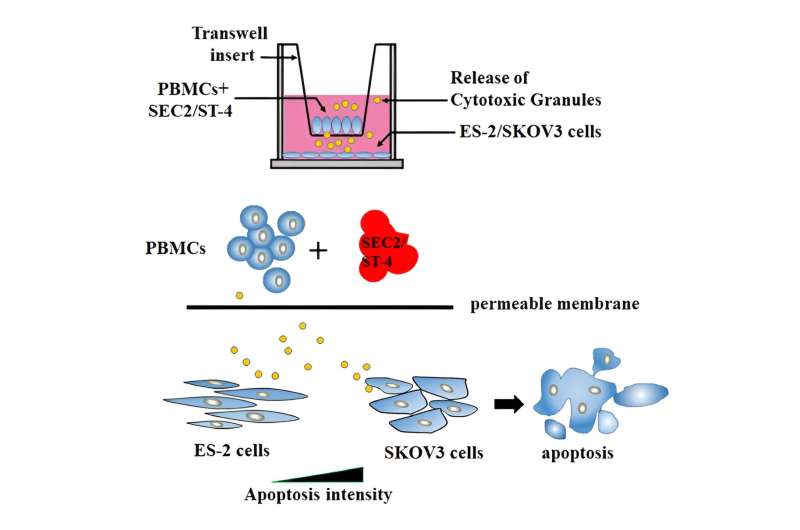The transwell co-culture models of transcriptome experiment. Credit: International Journal of Molecular Sciences (2023). DOI: 10.3390/ijms241411796
Superantigens are molecules that can stimulate a strong immune response by activating a large number of cytotoxic T cells, which are white blood cells that can eliminate tumor cells. One example of a superantigen is staphylococcal enterotoxin C2 (SEC2), which is produced by a type of bacteria.
A mutant of SEC2, called ST-4, has been constructed that can activate cytotoxic T cells more effectively. However, not all tumor cells are equally susceptible to the attack of cytotoxic T cells.
In a study published in the International Journal of Molecular Sciences, researchers from the Institute of Applied Ecology of the Chinese Academy of Sciences discovered that some ovarian cancer cells can resist the effects of SEC2 and ST-4 by changing their stiffness and preventing the destruction caused by a protein called perforin in their membranes.
The researchers used transcriptome analysis and atomic force microscopy to study how SEC2 and ST-4 affect two types of ovarian cancer cells: SKOV3 and ES-2.
They found that SKOV3 cells were more susceptible to SEC2 and ST-4 than ES-2 cells. The ES-2 cells could escape from SEC2/ST-4-induced cell apoptosis by regulating a signaling pathway involving two proteins: CDC42 and MLC2. In this way, ES-2 cells could avoid the damage caused by perforin, which is released by cytotoxic T cells to destroys cancer cells by creating lesion-like pores in their membranes.
Additionally, by manipulating the stiffness of ES-2 cells, the researchers found that these cancer cells could be more vulnerable to SEC2 and ST-4. This suggests that cell stiffness is an important factor in determining the outcome of superantigen-mediated immune therapy.
This study reveals new insights into how superantigens can be used to fight ovarian cancer and how tumor cells can develop resistance to them. It also suggests potential biomarkers and targets for improving the effectiveness of superantigen drugs.
More information: Xuanhe Fu et al, Staphylococcal Enterotoxin C2 Mutant-Induced Antitumor Immune Response Is Controlled by CDC42/MLC2-Mediated Tumor Cell Stiffness, International Journal of Molecular Sciences (2023). DOI: 10.3390/ijms241411796
Journal information: International Journal of Molecular Sciences
Provided by Chinese Academy of Sciences
























